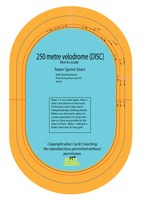Starting
The start of a team sprint is critical, if the lead rider gets too large a gap on the second (or third, for the men) the  chasing riders lose precious energy. If the lead rider starts to slow down before they swing off, riders following have to backpedal, which kills their effort. It's important to accelerate at a rate that everyone can go with, and to finish your lap faster than you started it, or at least not slowing down.
chasing riders lose precious energy. If the lead rider starts to slow down before they swing off, riders following have to backpedal, which kills their effort. It's important to accelerate at a rate that everyone can go with, and to finish your lap faster than you started it, or at least not slowing down.
One of the fundamental principles, in particular for the starter, is that the first lap time is of less importance than is the delivery speed that the starter gives to the second rider. This is difficult to measure in training without the use of speed measuring devices (typically power meters), as timed 50 or 62.5 meter splits don't tell the whole story. It can be quicker for the whole team for a starter to ride a slower first lap time but be accelerating out of the final bend, than to ride a blistering lap but be slowing around the corner (but not many starters will want to ride slower times - this is a difficult concept for some to grasp!). This makes gear choice a big issue. Traditionally starters have used smaller gears than their team mates but this may not always be optimal, as the smaller the gear, generally the greater loss of speed in the closing stage of the effort, which may jam the following rider or riders into backpedaling at a critical part of their effort.
It is also interesting to observe that many of the fastest team sprint times have been set by teams that have spread out by a few bike lengths (within the legal separation distance, of course, and also staying close enough to be benefiting from the draft) as by being spread out a following rider can take a run at the leader and accelerate to overspeed into a draft before the lead rider swings out of the way. This can mitigate the effect of a slowing lead rider and result in a faster overall time, despite appearing to be sub-optimal.
